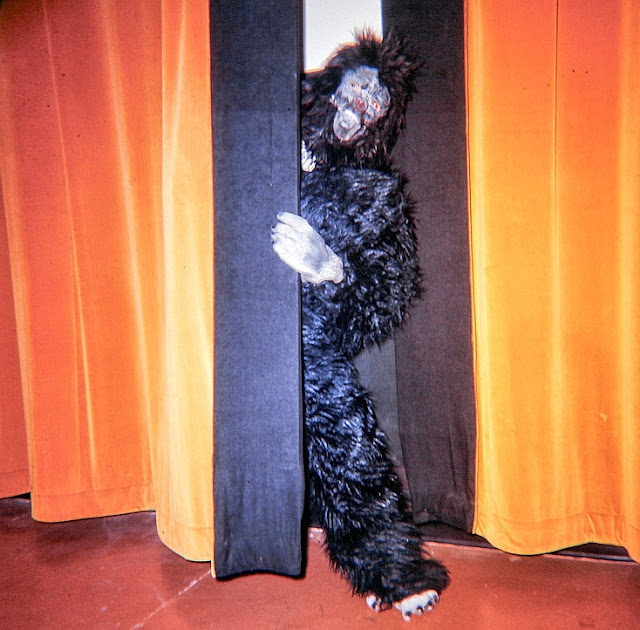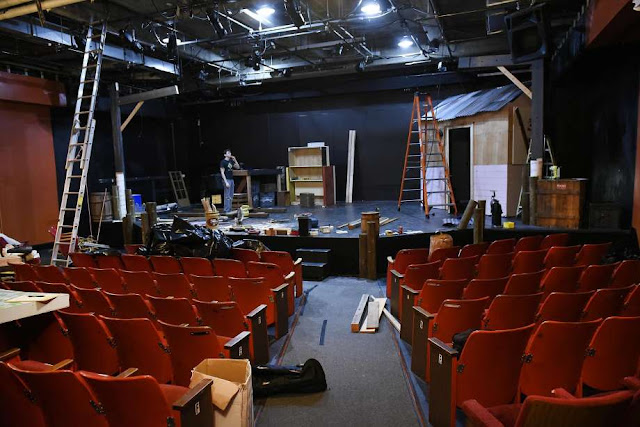Opened: November 15, 1967 on the street level of the then freshly-built Golden Gateway Center apartment and shopping complex. The theatre is on the south side of the street between Battery and Front. The photo from the Jack Tillmany collection is of a line during the 1974 engagement of "Robin Hood." Are you in the photo?
Phone: 415-255-8207 Website: 42ndstmoon.org | about the gateway |
Seating: 444 when it was a film house.
It was initially
operated by Edward and Roslyn Landberg, who also operated the Berkeley
Cinema Guild on Telegraph Avenue and the Cinema on Shattuck Avenue. They
had obtained the USA rights to the Japanese epic "Chushingura," which had
already proven popular in a record shattering ten month run in Berkeley
and wisely chose this to be their opening attraction at the Gateway.
The booth equipment included Simplex E-7s and Peerless Magnarcs. Sightlines at the flat-floored theatre were an initial problem, later corrected by adding platforming at the rear of the house.
As things turned out, the Landbergs divorced and divided up
the theatres, Edward continuing to operate the Berkeley sites, and
Roslyn taking over the Gateway, but there was never another "Chushingura"
and the Gateway, burdened with an unfamiliar location, a frustrating
lack of public transportation, and an inconsistent booking policy,
failed to find its audience.
After about 2 years of trial and error, the concept began to catch on, and by mid-decade, several thousand film enthusiasts from all over the San Francisco Bay Area, the majority of whom were not yet born when the Gateway's most popular films were first made, congregated nightly at the Jackson Street venue. Evergreens like "Gone with the Wind," "The Wizard of Oz," "The Thin Man," "Casablanca," "The Maltese Falcon," "It Happened One Night" and "His Girl Friday" never failed to attract sellout crowds.
Leading the popularity list was MGM's "San Francisco" (1936) with Clark Gable, Jeanette MacDonald and Spencer Tracy who faced and survived the devastation of MGM's realistically recreated earthquake and fire of 1906, and in which Jeanette MacDonald introduced the song which has since become San Francisco's anthem. Along with a variety of rare historical material including Thomas Edison's 1906 newsreel footage showing the ruins of the earthquake, the 1915 Panama-Pacific International Exposition, and 1943 color footage of the four track Market Street and Municipal Railway trolley systems on Market Street, selected from Tillmany's personal collection, this program became an annual event each and every April, on the anniversary of the infamous event.
Tim Phillips, a friend of Tillmany's, dressed up in a gorilla suit and wandered the city to promote "King Kong" in September 1973. Here he's working a cable car.
Without a doubt, the Gateway's finest hour occurred in the fall of 1974 when Tillmany, unable to locate an acceptable color print of WB's "Adventures of Robin Hood" (1938), subsidized a new IB Technicolor transfer, freshly struck in England from the original separation negatives. Sellout crowds enthusiastically responded for three capacity weeks, and similar response took place as the lone print wound its way back and forth across the USA in similar revival venues.

Following the overwhelming success of "It Happened One Night" (1934) and "His Girl Friday" (1939) at the Gateway's Christmas program in December 1974, Columbia Pictures inaugurated their Columbia Classics sub-division whereby fresh 35mm prints of titles chosen by revival venues such as Tillmany's, which had since sprung up all over the USA, were made available to whoever chose to put up the required guarantee in advance, and so a library of vintage titles was built up, chosen by the very exhibitors who wished to show them.
Several original vintage 3-Sheets from Tillmany's collection displayed on the lobby's south wall during his Columbia Pictures festival.
Correct aspect ratio presentation had always been a personal fixation of Tillmany's, and so, while vintage films were of course projected in their original 4:3 format, the Gateway could also adequately handle CinemaScope and Panavision, with no cropped sides, no dropped top, if and when called for by "Lawrence of Arabia," "Rose Marie " (Ann Blythe version), "Sweet Charity," "Cleopatra" (Elizabeth Taylor version), or any of their other wide screen siblings. Jack discusses the booking of "Word Is Out" in 1977:
"We even sold T-shirts at the snack bar, and were always running out of 'small' because the guys wanted them as tight as they could get them, and 'large' and 'extra large' because that's the size the women needed. Nobody ever wanted a 'medium.' It was like a 3-ring circus, with nothing but 100% positive vibes, and lots of return customers. Yes, we even sold bumper stickers and I forget what else. Adair's group provided a 'signer' who stood on a little platform just to the left of the screen, and interpreted it for the hearing impaired. Everybody clapped along with that hot musical number by Buena Vista. Lots of tears too. Obviously reached plenty deep in many cases.
"I don't remember the exact numbers, but I know the first week topped $10,000, with lines around the block, 2 shows per evening and a midnight show Saturday. The thing just wouldn't quit, and we ended up running it 15 weeks, all the way into March 1978. Meantime the usual Gateway audience were grumbling, so I told them to go to the Richelieu; some did; some didn't; c'est la guerre. By the end of 15 weeks Mariposa Group was just barely grossing their 4-wall weekly rental figure, so I tried to convince them to move it over to the Richelieu where I offered them a much better deal at about half the price, and promised to help them to continue to promote the film. But they opted for a deal at the Lumiere, where it came and went in a couple weeks. Too bad. I bet I could have stretched it out indefinitely at the Richelieu. I think it may have returned to the Castro later on, but without the hoopla."
In June 1979 the King Tut Exhibit was in full swing at the De Young Museum, and Tillmany chose to offer an opposing view of vintage Egyptology with the premiere revival of Claudette Colbert in Cecil B. De Mille's "Cleopatra" (1934). The Sunday San Francisco Chronicle Datebook heralded the event with a front page announcement, and full page story inside, 45 years after the film was first released!
The June 1979 Chronicle article by Norman K. Dorn about the Gateway's booking of the Claudette Colbert version of "Cleopatra." As noted in the article, Elizabeth Taylor offered moviegoers her version at the Gateway one week later.
In October 1980, feeling playful, and in need of something "special" to show for Halloween that might prove interesting enough to lure some of his patrons away from San Francisco's many other Halloween diversions, Tillmany came upon a clever idea and tossed it to John Stanley, the popular local radio and television personality, also a feature writer for the San Francisco Chronicle. Stanley gave it a hearty thumbs up, and devoted a full page piece that said so well, in his own unique style, it has to be read in its entirety. Needless to say, the results were over the top, as over 1000 celebrants, many of them in costume, came and went, in and out, during that one memorable evening. A dedicated few made it from start to finish, others only stayed long enough to get a taste, have some popcorn, then get on to other fun and games.
The new operators chose to go the route of contemporary foreign and domestic independent films, and were enormously successful with their initial offering, "My Dinner with Andre." But lightning failed to strike twice, and they eventually sold out to other local entrepreneurs, such as Michaan and Landmark, who were also unable to inject the spark of life into the operation.
A year and a half later, like Phoenix rising from the ashes, the Gateway found new life under a new name as the Eureka Theatre, a home of the local Eureka Theatre Company. The house reopened March 20, 1998 with a staging of Carl Djerassi's "Menachem's Seed."
Looking east on Jackson St. in 2016 with the Eureka Theatre's kiosk over on the right. Photo: Google Maps
A look at the former film house as a legit venue. It's a Michael Short photo appearing with "A new era of resource sharing in Bay Area theaters," a May 2017 Chronicle article by Lily Janiak.
In July 2017 42nd Street Moon took over management of the facility and now identifies it as "the Gateway Theatre formerly the Eureka Theatre." At the time, they were working on obtaining a long-term lease. So in its own way, it's come full circle. In addition to productions by 42nd St. Moon it's also home to Theatre Rhinoceros and SF ArtsEd.
More about Jack Tillmany: He's alive and well and living in Walnut Creek and has authored three books for the Arcadia Publishing Company: "Theatres of San Francisco" (2005), "Theatres of Oakland," with Jennifer Dowling (2006), and "Theatres of the San Francisco Peninsula," with Gary Lee Parks (2010), all of which you can pick up at Amazon.
The page about Jack in "Legendary Locals."























No comments:
Post a Comment